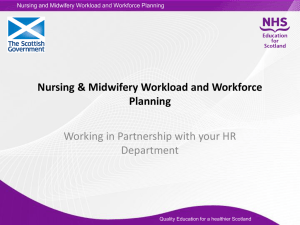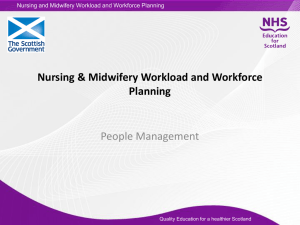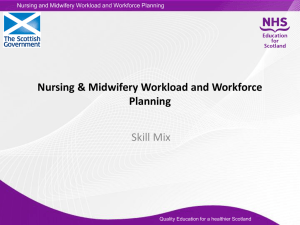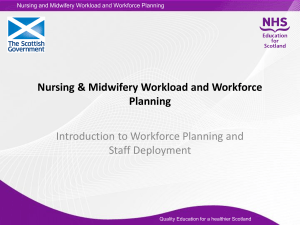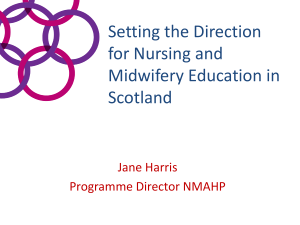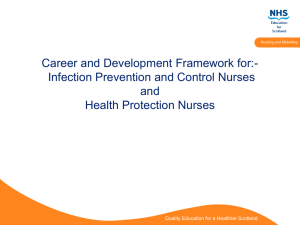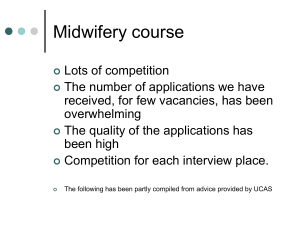Planning and managing staff resource
advertisement
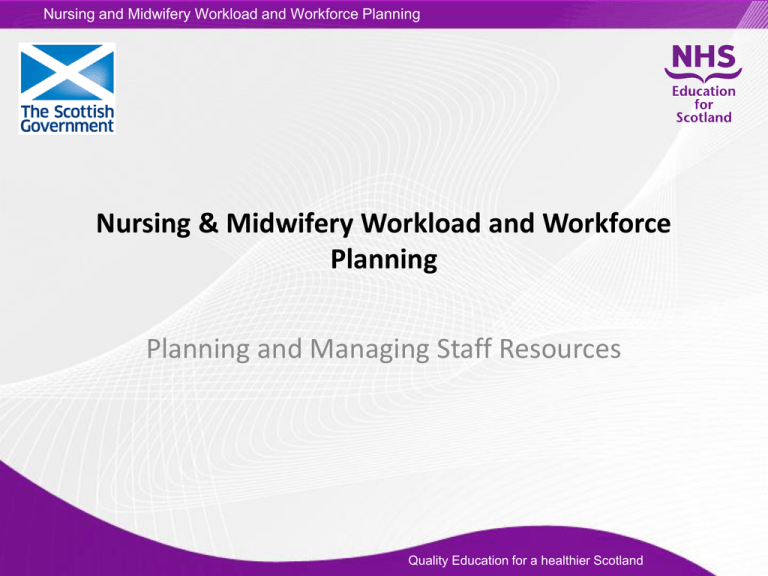
Nursing and Midwifery Workload and Workforce Planning Nursing & Midwifery Workload and Workforce Planning Planning and Managing Staff Resources Quality Education for a healthier Scotland Nursing and Midwifery Workload and Workforce Planning A roster for nursing and midwifery staff is a plan showing on and off duty periods for staff within a defined area such as a ward or community locality. The plan should reflect the peaks and troughs of expected workload, ensuring staff are available at the times they are required • Rostering affects: – patient care – Budgets – Staff morale/ wellbeing • Rostering requires skills in: – planning – knowledge of expected workload activity – knowledge of patient care – collaboration – communication Quality Education for a healthier Scotland Nursing and Midwifery Workload and Workforce Planning Methods • self rostering • computerised rostering (e-roster) • rotational roster • manual off duty Quality Education for a healthier Scotland Nursing and Midwifery Workload and Workforce Planning Principles of Rostering Whatever method is used however, the following principles should apply: • the rota should be available to staff at least four weeks in advance and modified to take into account unexpected events • methods of rostering and shift patterns should be reviewed regularly • the rota should be kept as a legal document as it shows who was working when • rota and shift patterns should reflect European Work Time Directives which should be incorporated into hospital policies Quality Education for a healthier Scotland Nursing and Midwifery Workload and Workforce Planning Rostering Protocols Rostering should be supported by clear protocols to guide decision-making. Such protocols should include rules about: • minimum and maximum skill levels • minimum and maximum staffing numbers • procedures to be followed in the event of unplanned absences • procedures for the use of bank and agency staff • maintenance records • audit requirements • length of shifts • nature of individual’s shift patterns Quality Education for a healthier Scotland Nursing and Midwifery Workload and Workforce Planning Why Modernise our Rostering Practices? • Social Change: – society demands greater efficiency – increased patient choice in the health care system – public more informed • Political and Professional Change: – recent policy documents • Workforce change: – staff want greater flexibility and ‘work/life balance’ is becoming more important – improved working conditions – greater involvement in decisions which affect them Quality Education for a healthier Scotland Nursing and Midwifery Workload and Workforce Planning Why Modernise our Rostering Practices? (2) • Technological Change: – IT gives opportunity to modernise • Organisational Change: – SCNs, SCMs & TLs to become more strategic – drive for greater empowerment of workforce – need to proceed on a partnership basis Quality Education for a healthier Scotland Nursing and Midwifery Workload and Workforce Planning Building an Effective Roster The principles of accountability in rostering according to the Office for Health Management (2003) are: • patient and service needs come first • involve staff as much as possible • consider staff competence • be fair and flexible • agreeing for one person sets a precedent – think twice • communicate verbally and in writing • then communicate again! Quality Education for a healthier Scotland Nursing and Midwifery Workload and Workforce Planning Framework For Building An Effective Roster 1. Matching demand with an appropriate supply of nurses 2. Allocating a unit’s budgeted WTE 3. Determining and allocating a suitable mix of competency and experience Quality Education for a healthier Scotland Nursing and Midwifery Workload and Workforce Planning Building An Effective Roster • To roster an appropriate number of staff you will need to be aware of: • • WTE establishment for your ward / department predicted absence allowance (22.5%) Indicative breakdown: – 14.5% annual leave – 4% sickness – 1% maternity leave – 2% study leave – 1% other annual leave the numbers and skill mix of staff required to meet workload ‘peaks and troughs’ throughout the day and / or across the week local protocols / guidance • • Quality Education for a healthier Scotland Nursing and Midwifery Workload and Workforce Planning Planned Time Out and Absenteeism • difficult to estimate accurately • nationally agreed minimum predicted absence allowance of 22.5% built into in patient staffing budget • unplanned absences through employee sickness disrupt service provision and increases costs of providing services • patterns may indicate that there are aspects of the working environment that require management attention • HR employment policies Quality Education for a healthier Scotland Nursing and Midwifery Workload and Workforce Planning Use of Agency and Bank Staff The Nationally Co-ordinated Nurse Bank Arrangement: Report and Action Plan (SEHD, 2005c): • analysed the pattern of usage of bank nurses • NHS boards should set targets on an annual basis to reduce the proportion of complementary staff utilised from agency as a percentage of the total nurse staff deployment • ensure policies and procedures are in place A Good Practice Guide in the Use of Supplementary Staffing (Scottish Government, 2007c): • highlights the organisational policies and responsibilities of those who manage the nurse/midwife staffing resource • provides rationale and means of assessing the ward, care setting or organisational position Quality Education for a healthier Scotland
